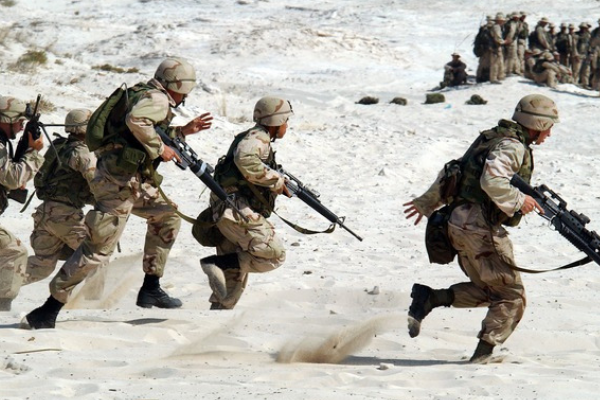
The Fall and Rise of Neoconservatism
Read a summary using the INOMICS AI tool
In its short and controversial history, neoconservatism has changed America. For almost 60 years, the ideology has variously been embraced and rejected; celebrated for its patriotism and commitment to democracy; and disdained for it hawkish arrogance and imperialistic tendencies. It has simultaneously proven uniquely divisive, while also unifying people across party lines. Quite simply, recent American political history cannot be made sense of without an understanding of neoconservatism; such has been its influence.
The election of Barack Obama in 2008 and the withdrawal of American troops from Iraq three years later was supposed to mark the decline of its influence, a decline that was widely believed would be terminal. After a decade of war, people were weary and with inequality spiralling, problems at home were considered of greater concern than escapades abroad. It felt like a spent force. The political arena reflected this too: the term ‘neocon’ was reduced to an epithet, a word of derision for Democrats, and occasionally even moderated Republicans, to hurl when in heated debate and seeking to score cheap points. Over time it lost much of its meaning - no longer a reliable indicator of political outlook, simply a way to denounce or discredit.
 And then came the election of Donald Trump, and like with much else, things changed. Despite his campaign blasting neocon’s signature policy, the invasion of Iraq, as a ‘big fat mistake’, Trump’s presidency has offered neocons a way back. In his three tumultuous years in office, his administration has welcomed back into the fold architect of the Iraq invasion and chief hawk, John Bolton, now National Security Advisor; and appointed war-enthusiast, Mike Pompeo, as Secretary of State. The political persuasion of both is well known, and in the case of Bolton, his penchant for war may well be his defining characteristic.
And then came the election of Donald Trump, and like with much else, things changed. Despite his campaign blasting neocon’s signature policy, the invasion of Iraq, as a ‘big fat mistake’, Trump’s presidency has offered neocons a way back. In his three tumultuous years in office, his administration has welcomed back into the fold architect of the Iraq invasion and chief hawk, John Bolton, now National Security Advisor; and appointed war-enthusiast, Mike Pompeo, as Secretary of State. The political persuasion of both is well known, and in the case of Bolton, his penchant for war may well be his defining characteristic.
A similar trend can be seen in the media. Newspapers and magazines have increasingly been featuring opinion of a neocon bent. From the New York Times to the Atlantic, the development is a marked one. With bellicosity of this kind on the up, consuming not just op-eds but presidential addresses, the feeling is eerily familiar - the neocons are asserting themselves, flexing their muscles once more.
Suggested Opportunities
- Postdoc Job
- Posted 3 days ago
Postdoctoral Researcher in Behavioral/ Experimental Economics (m/f/d)
At Düsseldorf Institute for Competition Economics (DICE) - University of Düsseldorf in Düsseldorf, Deutschland- Postdoc Job
- Posted 4 days ago
Postdoctoral Researcher in Empirical Microeconomics (m/f/d)
At Düsseldorf Institute for Competition Economics (DICE) - University of Düsseldorf in Düsseldorf, DeutschlandA short history of neoconservatism
Given its overuse, a detour back to its origins and early development helps get a better handle on the ideology and its more dangerous proclivities. Neoconservatism was a child of the 1960s, born in response to the New Left and the growing pacifism that emerged in and alongside the anti-war movement. The hallmark of its early adherents - many who identified as liberals – and the source of their zeal, was an uncompromising opposition to the totalitarian Soviet Union. Fearful that the West was ‘losing its purpose’, its fingers slipping on the mantle of global moral arbiter, neocons advocated a strident foreign policy, in which America took centre stage. They scorned Nixon and Carter’s respective attempts at détente with the Soviet Union - conciliatory politics in the face of tyranny was anathema - and celebrated Reagan’s more confrontational approach to Cold War diplomacy.
When the Iron Curtain did finally fall, it was a moment both of vindication and trepidation. Buoyed by democracy’s triumph over dictatorship, they were also - with the removal of the Soviet threat - denied their rallying point, their common cause. Rhetorically speaking, with no enemy they were left toothless. It was in this environment of doctrinal uncertainty that a group of its younger acolytes, including one Paul Wolfowitz, came together to explicitly reinstate the ideology’s key principles and to reinvigorate the movement. The paper was innocuously titled the ‘Defense Planning Guidance’; it soon became known as the Wolfowitz Doctrine.
The paper expressed a desire to construct a world based on American ideals that would be driven by American-directed economic growth. This would, in turn, encourage the emergence of American-style democracies, where previously there had been despotism. The world was to be administered by alliances and inter-governmental organisations led, naturally, by the U.S, and protected by means of assertive diplomacy, economic sanctions, and when necessary, the American military. In certain cases, pre-emptive military action was believed to be justified. In short, the paper’s primary concern was to prevent the emergence of a rival global power. No region was to be dominated unless under the direct supervision of the US; only then could American safety be assured. Although not to a tee, these core principles informed most US foreign policy, irrespective of government, throughout the 90s and into the 00s.
Neocons in crisis
The project culminated in the invasion of Iraq in 2003. The ousting of Saddam Hussein - premised, as we know now, on twisted intelligence - was to serve as a Petri dish for reform of the entire Middle East and the attempt to spread democracy in the region. It was, in effect, a test of the base assumptions of neoconservatism.
The policy was a disaster. Over a decade later, Iraq remains in chaos, ravaged by cycles of war, and the Middle East is more fractured and less stable since intervention. Through the failure, the ambitions of the neocons were brutally checked. Their idealism, based in large part on their arrogance, had clashed violently and catastrophically with reality. They were forced to confront the fact that America was not the omnipotent force they presumed, that the imposition of elections alone cannot transform a country, and that to think either was to be unacceptably naïve or unforgivably reckless.
Re-birth?
And this was supposed to be the end of it, humiliation the final death knell. Neoconservatism was, for most, no longer intellectually credible, its agenda bankrupt. The corridors of power were as far away as they had ever been. And a return looked improbable, if not impossible. That was until Trump. Under his presidency, erratic as it’s been, the impulses of neoconservatism are once again audible, and getting louder.
In a contradictory series of events, their re-emergence actually began with Trump castigating the neocon project, deriding the Iraq War and talking down the possibility of future overseas intervention. His campaign promised a focus on Americans, plans framed largely economically: how money was to be saved, where costs could be cut etc. The expense of conflict made it unappealing and to be avoided. Three years in office, however, and things now look very different. The revolving door of his administration has let in hawks John Bolton and Mike Pompeo, who, in the absence of a confirmed Secretary of Defence, are de facto Trump’s most influential foreign policy advisers. And their effect is being felt.
On assuming their respective roles, both set about asserting their long-held contempt for Iran, quickly bending U.S foreign policy to such feeling. Bolton has repeatedly insisted on the necessity of military action to deal with the ‘rogue’ government, an obsession that has consumed him for the better part of three decades, while Pompeo has declared that ‘there is no doubt… a connection between al-Qaeda an Iran’, and that the country’s continued ‘bloodletting and lawlessness’ needs to be stopped. With the relentless admonishments ringing in Trump’s ears, the increasingly agreeable president was easily persuaded to abandon the Iran nuclear pact. The deal had no bearing on Tehran’s desire to develop nuclear weapons, his two advisors reasoned, and therefore served little purpose. For Trump, the opportunity to dismantle any part of Obama’s legacy has rarely required much justification.
Soon after, the duo pushed through the decision to designate Iran’s Revolutionary Guard as a terrorist group, against the advice of many military officials who warned it might encourage retaliation. In true neocon speak, Pompeo explained it as part of an attempt to ‘help the people of Iran get back their freedom’. Again, Trump quickly acquiesced. The openness and conviction with which this hawkish hostility is held appears to be infectious, the free-flying browbeating emboldening other lower profile Republicans to also speak out. Arkansas Sen. Tom Cotton, for instance, recently joined the fray, boasting that the U.S. could defeat Iran in ‘two strikes, the first strike and the last strike’.
Ominously, these developments are taking place in a growing ecology of neoconservative thinking by no means exclusive to Trump’s inner circle. Prominent journalists Ari Fleischer, Max Boot, and Robert Kagan are all regularly talking up the advantages of a pre-emptive strike on Iran to their large and loyal audiences, while broadly liberal publications have been reserving countless column inches for those hankering after conflict. Bret Stephens, writing for the New York Times, declared only this month that if Iran doesn’t change its behaviour, ‘we should sink its navy’.
Talk of this kind is dangerous; that invasion is viewed so simply, staggering. As analyst Aaron David Miller has said, in case of invasion Iran ‘has many options available to it’. It is a powerful nation with proxies situated throughout the region. Utilising them, as it would if conflict arose, it easily commands enough military strength to badly hurt America: Hezbollah could strike Israel, Shia militias in Iraq could attack American forces, and Iranian backed groups could go after Americans in both Syria and Yemen. The conflict would be messy and destabilise a region already so fractured and volatile.
Despite this, according to reports, the Pentagon is planning to increase American presence in the region by 5000-10,000 troops, this after an aircraft carrier, bomber planes and anti-missile batteries have already been sent. Trump has also committed to significantly enlarging military spending, what would be the largest increase in the country’s history, and at the end of June 2019 reportedly blocked a US strike on Iran 10 minutes before it was planned. The signs are not good. War with Iran looks closer than it has done for many years. Neocons have infiltrated the Whitehouse, and are bending the ear of its attention-seeking inhabitant, acclimatising him to their sabre-rattling rhetoric. Meanwhile, an increasingly compliant media is egging them on. The necons may not be huge in numbers but, evidently, they occupy positions of serious influence. For the sake of peace, it's time we all took notice.
-
- Postdoc Job
- Posted 4 days ago
Postdoctoral Researcher in Empirical Microeconomics (m/f/d)
At Düsseldorf Institute for Competition Economics (DICE) - University of Düsseldorf in Düsseldorf, Deutschland
-
- Assistant Professor / Lecturer Job
- Posted 2 weeks ago
Full-time assistant professor position in economics with a demonstrated interest in environmental economics
At University of Namur in Namur, Belgien
-
- Konferenz
- Posted 1 week ago
45th RSEP International Multidisciplinary Conference
Between 4 Feb and 5 Feb in Lisbon, Portugal














